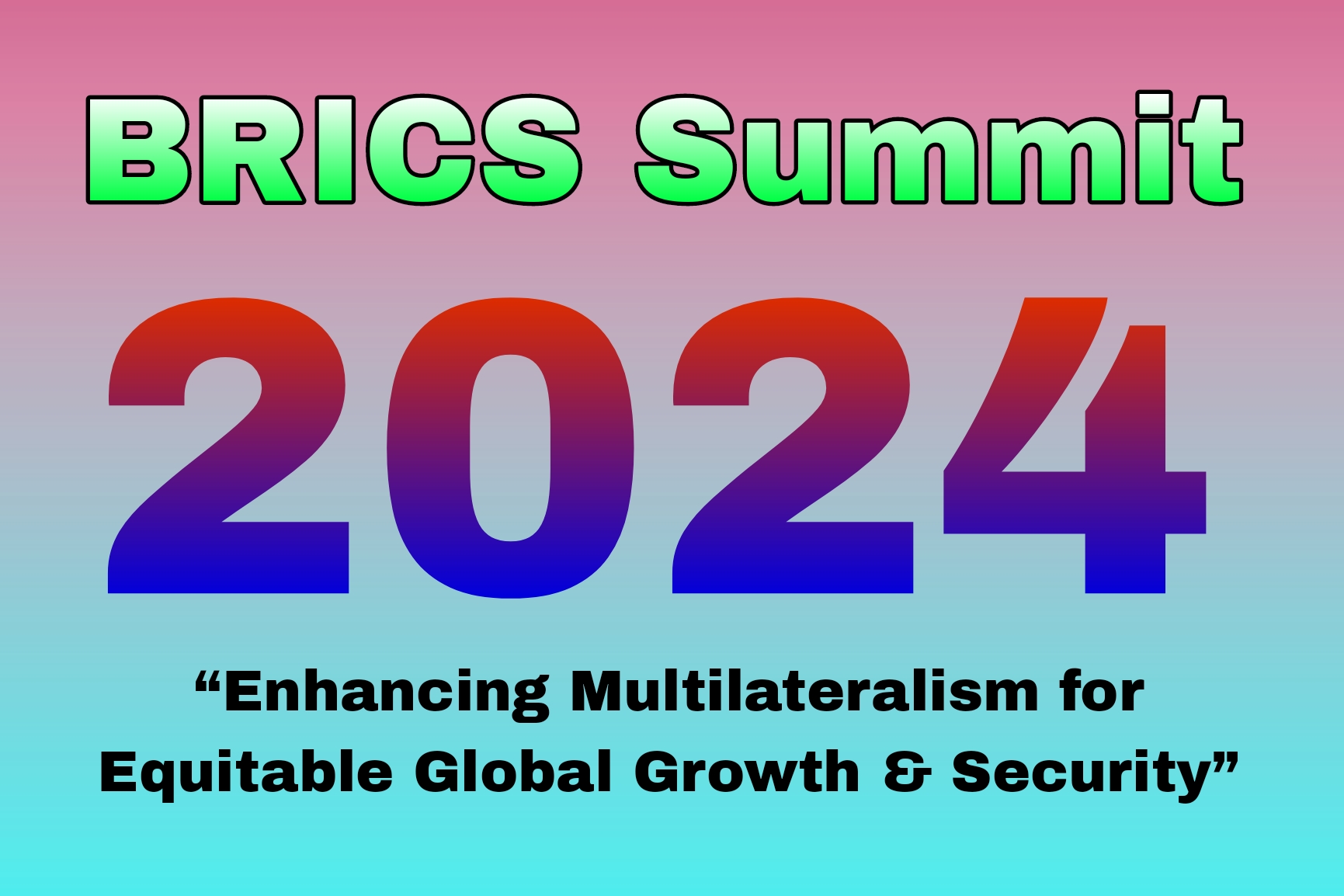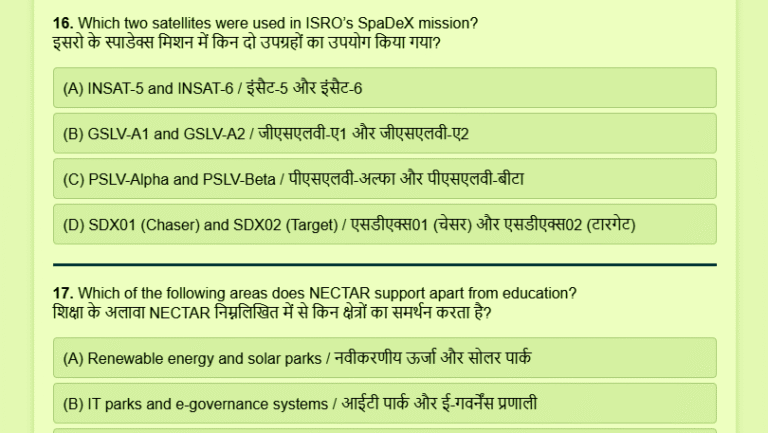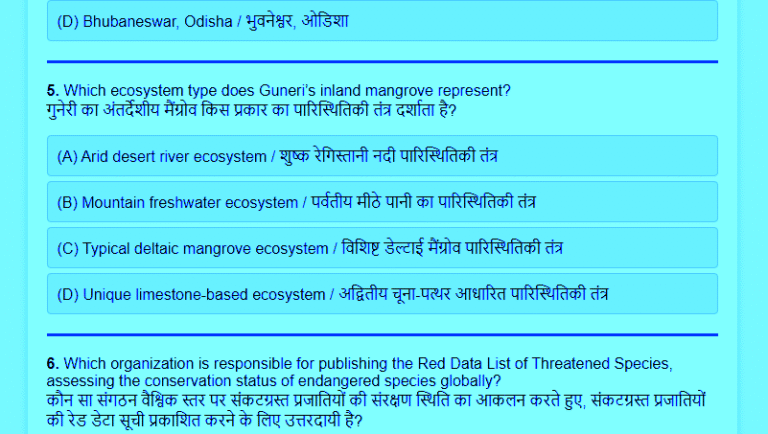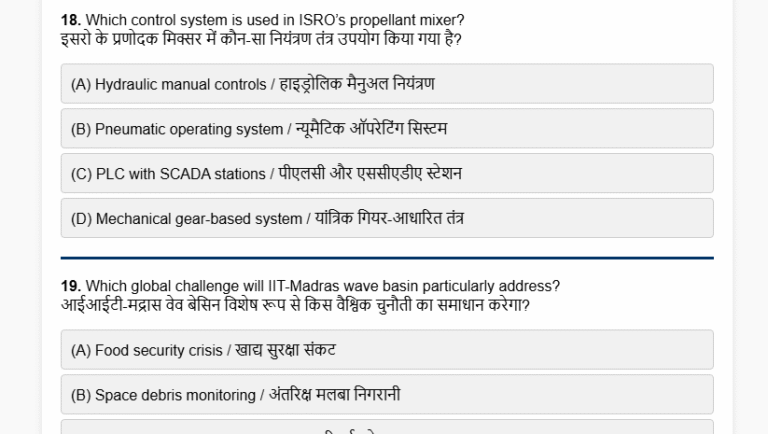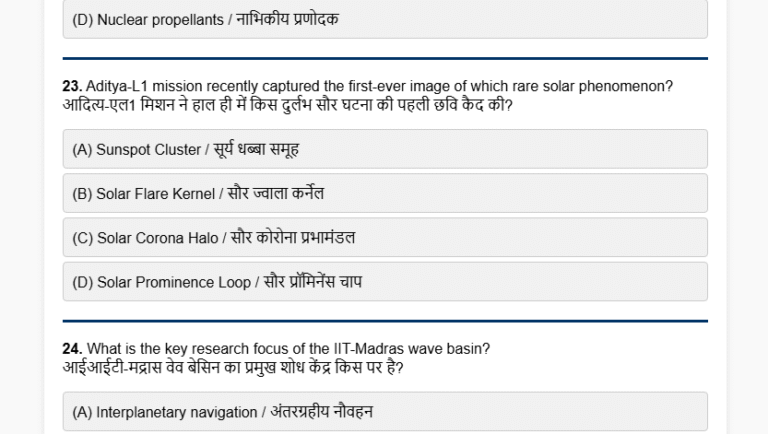16th BRICS Summit and Kazan Declaration
The 16th BRICS Summit, hosted by Russia in Kazan, has garnered attention as the emerging economies of Brazil, Russia, India, China, and South Africa came together to address global challenges and outline strategic goals for sustainable growth and fairer global governance. For India, the summit offered opportunities to strengthen South-South cooperation, address regional stability, and expand economic engagement with newly joined BRICS members including Argentina, Egypt, Ethiopia, Iran, Saudi Arabia, and the UAE. Against the backdrop of a complex global landscape marked by economic volatility and geopolitical shifts, the BRICS summit also served as a platform for discussions on alternative financial systems, energy security, sustainable development, and support for global South nations.

Theme of BRICS Summit 2024
The theme for the 2024 BRICS Summit is “Enhancing Multilateralism for Equitable Global Growth and Security.” This theme reflects the group’s commitment to fostering a fair international order where all countries have a voice. It focuses on tackling the issues that developing nations face, particularly in trade, investment, and security.
As the chair for this year, Russia has emphasized the importance of economic independence and reducing reliance on Western economies. Under this theme, BRICS nations aim to build stronger connections with each other and with nations in the Global South, working toward a more balanced and inclusive global framework.
1. Economic Growth and Cooperation
One of the primary objectives discussed was boosting intra-BRICS trade and reducing reliance on Western economies. Leaders emphasized:
- Enhancing Trade and Investment:— Encouraging trade among BRICS nations to support mutual economic growth and resilience.
- Promoting Sustainable Development:— Fostering sustainable practices across industries, including renewable energy, green technology, and agriculture.
- Alternative Payment Systems:— Discussing the establishment of a common payment system that bypasses the US dollar to mitigate currency risks and protect BRICS economies from Western sanctions.
- New Development Bank (NDB) Initiatives:— Increasing NDB’s funding for projects within BRICS countries, focusing on infrastructure, green energy, and technology development.
2. Security and Geopolitical Stability
In light of rising global tensions, BRICS leaders addressed the importance of collaboration to ensure security and stability. Key points included:
- Counter-Terrorism Efforts:— Strategies to prevent terrorism, enhance intelligence sharing, and improve cyber defenses among BRICS nations.
- Cybersecurity Measures:— Joint initiatives to combat cyber threats that pose risks to national security, economies, and infrastructure.
- Regional Stability:— Discussions on peaceful solutions to regional conflicts, especially those affecting BRICS nations or their interests, such as in Africa, Asia, and Latin America.
- Defense Cooperation:— Strengthening defense cooperation and exploring collaborative efforts in military technology to protect BRICS interests and maintain geopolitical stability.
3. Climate Action
BRICS countries acknowledged the urgency of climate change and the need for coordinated efforts to combat its impact. They discussed:
- Renewable Energy Projects:— Increasing investments in renewable energy, such as wind, solar, and hydroelectric power, to transition away from fossil fuels.
- Sustainable Infrastructure Development:— Promoting green infrastructure projects to support low-carbon growth in urban development, transport, and industry.
- India’s Initiatives:— India invited BRICS members to participate in initiatives like:
- International Solar Alliance (ISA):— An alliance aimed at reducing dependence on fossil fuels by promoting solar energy use worldwide.
- Coalition for Disaster Resilient Infrastructure (CDRI):— A group dedicated to building disaster-resilient infrastructure, reducing risks in climate-sensitive regions.
- Ek Ped Maa Ke Naam (A Tree in Mother’s Name):— A tree-planting campaign to promote environmental awareness and reforestation efforts.
- Green Credits:— A system encouraging sustainable practices by rewarding companies and individuals who engage in eco-friendly activities.
4. Advocacy for the Global South
BRICS leaders highlighted their commitment to advocating for the Global South in international forums. Points of focus included:
- Representing the Global South’s Interests:— BRICS aimed to ensure the concerns of developing countries are addressed in global governance discussions, especially concerning trade, climate change, and economic reforms.
- Support for Inclusive Growth:— Promoting equitable growth that benefits low-income countries and reduces poverty and inequality.
- Reform of International Institutions:— Calls for reforming institutions like the United Nations and the World Bank to give more representation to developing nations, ensuring their voices have greater influence in decision-making.
5. Strengthening Cultural and Humanitarian Ties
The summit emphasized the importance of cultural connections and humanitarian cooperation, which serve as pillars for stronger relationships among BRICS members. This included:
- Cultural Exchanges:— Initiatives to promote cultural understanding, such as art exhibitions, language programs, and academic exchanges.
- Educational Initiatives:— Collaborative education programs that provide scholarships, research opportunities, and vocational training across BRICS nations.
- Humanitarian Aid:— Coordinating humanitarian aid and disaster response, particularly in regions affected by climate change or conflicts.
Kazan Declaration 2024
The summit concluded with the adoption of the Kazan Declaration, which outlined BRICS’ shared goals and reaffirmed their commitment to solidarity and strategic partnerships. The declaration emphasized:
- Mutual Support:— Strengthening partnerships across economic, security, and social sectors to achieve collective resilience.
- Sustainable Development Goals (SDGs):— Aligning BRICS initiatives with the United Nations’ SDGs, particularly those related to poverty reduction, clean energy, and sustainable cities.
- Enhanced Role on the World Stage:— Reinforcing BRICS as a powerful coalition advocating for multipolarity in global governance, opposing unilateral policies, and promoting peace and stability worldwide.
The Kazan Declaration reflects BRICS’ vision of a multipolar world order, where diverse voices are respected, and cooperation leads to collective progress.
Understanding BRICS
Initially coined by economist Jim O’Neill in 2001 to signify Brazil, Russia, India, and China (BRIC) as emerging economic powerhouses, the BRICS alliance formally incorporated South Africa in 2010. Together, BRICS represents around 45.2% of the world population and nearly one-third (36.7%) of the global GDP, making it a formidable alliance for addressing challenges beyond the traditional Western-dominated G7. The latest expansion includes Argentina, Ethiopia, Egypt, Iran, Saudi Arabia, and the UAE, further increasing its global influence.
| S. No. | Year | Host Country | Important Events |
|---|---|---|---|
| 1st | 2009 | Yekaterinburg, Russia | The inaugural BRICS summit, where leaders from Brazil, Russia, India, and China (BRIC) met to discuss economic cooperation. |
| 2nd | 2010 | Brasília, Brazil | Discussions focused on economic policies and the global financial crisis. |
| 3rd | 2011 | Sanya, China | South Africa joined as a member, officially transforming BRIC into BRICS. |
| 4th | 2012 | New Delhi, India | The summit emphasized global governance reforms and sustainable development. |
| 5th | 2013 | Durban, South Africa | Leaders agreed to establish a BRICS Development Bank (NDB). |
| 6th | 2014 | Fortaleza, Brazil | Agreements signed for the New Development Bank (NDB) and the BRICS Contingent Reserve Arrangement. |
| 7th | 2015 | Ufa, Russia | The NDB and BRICS Contingent Reserve Arrangement were officially launched. |
| 8th | 2016 | Goa, India | Joint summit held with BIMSTEC to strengthen regional cooperation. |
| 9th | 2017 | Xiamen, China | Focus on BRICS Plus initiative, inviting non-member countries to participate in dialogue. |
| 10th | 2018 | Johannesburg, South Africa | Discussions on the Fourth Industrial Revolution and Africa’s development. |
| 11th | 2019 | Brasília, Brazil | Focus on innovation, digital economy, and infrastructure development. |
| 12th | 2020 | Saint Petersburg, Russia (Online) | Originally planned as a joint summit with SCO; held online due to COVID-19, with focus on global pandemic response. |
| 13th | 2021 | New Delhi, India (Online) | Summit held via video conference; discussions included multilateralism, counter-terrorism, and post-COVID recovery. |
| 14th | 2022 | Beijing, China (Online) | Hosted virtually due to COVID-19, the summit focused on multilateralism and global economic recovery. |
| 15th | 2023 | Johannesburg, South Africa | Discussions centered around expanding BRICS membership, and Argentina, Egypt, Iran, Ethiopia, Saudi Arabia, and UAE were invited to join. |
| 16th | 2024 | Kazan, Russia (Planned) | The 2024 BRICS Summit held in Kazan, Russia, addressed critical global issues with a focus on enhancing cooperation and strengthening the role of BRICS on the international stage. |
Headquarters of BRICS
BRICS doesn’t have a centralized headquarters. Instead, it functions as a cooperative forum where member nations collaborate on various global issues. The structure emphasizes flexibility, allowing each member country to host meetings and summits in rotation.
New Development Bank (NDB)
Formed in 2014 and operational since 2015, the New Development Bank (NDB) is based in Shanghai, China. Established by BRICS nations, the NDB provides financial support for infrastructure and development projects, particularly in emerging economies. It aims to support sustainable development and complement other financial organizations. The NDB’s first president was Mr. K.V. Kamath from India, and the current president is Dilma Rousseff from Brazil.
New Development Bank (NDB)
The New Development Bank (NDB) is a multilateral development bank established by the BRICS nations (Brazil, Russia, India, China, and South Africa) during the 6th BRICS Summit held in Fortaleza, Brazil, in 2014 and operational since 2015. Created to support infrastructure and sustainable development projects, particularly in BRICS countries and other emerging economies, the NDB aims to accelerate development by harnessing innovative approaches and advanced technology. The bank’s headquarters is located in Shanghai, China. The NDB’s first president was Mr. K.V. Kamath from India, and the current president is Dilma Rousseff from Brazil.
In 2018, the NDB was granted observer status by the United Nations General Assembly, providing a foundation for closer cooperation with the UN and enabling the NDB to participate in UN discussions on sustainable development and related issues.
Objectives of NDB
The NDB’s objectives are focused on:
- Supporting the development of its member countries,
- Encouraging economic growth,
- Enhancing competitiveness and facilitating job creation,
- Building a knowledge-sharing platform among developing nations.
To achieve these goals, the NDB offers financial support for both public and private projects using instruments like loans, guarantees, equity investments, and other tools to facilitate development.
Major Projects Funded by NDB in India
The NDB has played a crucial role in funding significant infrastructure projects in India. Some key projects include:
- The Mumbai Metro rail project,
- The Delhi-Ghaziabad-Meerut Regional Rapid Transit System,
- Various renewable energy projects to support India’s green energy initiatives.
To date, the NDB has approved 14 projects in India, totaling approximately USD 4.2 billion in funding. In 2020, India secured a USD 1 billion loan from the NDB to enhance rural employment opportunities and support rural infrastructure development, reflecting the bank’s commitment to social and economic upliftment in member countries.
BRICS Contingent Reserve Arrangement (CRA)
Established in 2014, the BRICS CRA aims to provide financial support to member nations during economic crises. It offers short-term liquidity assistance through currency swaps, helping members manage balance of payments challenges. The CRA strengthens financial cooperation and stability among BRICS countries and complements global financial systems like the International Monetary Fund (IMF).
BRICS Pay
BRICS Pay is an initiative to create a unified financial and payment system across BRICS countries and their partner nations. Its objective is to ensure equitable access to financial technologies while promoting a fair, decentralized global financial network. The BRICS Pay Consortium, involving various technology and financial firms, is developing solutions to facilitate cross-border payments and strengthen economic ties within BRICS.
Recent Events (2021-2024)
- 2021 (New Delhi, India):— This BRICS summit was held virtually due to the COVID-19 pandemic. Key discussions revolved around strengthening multilateral institutions, countering terrorism, and strategies for post-pandemic economic recovery. Leaders emphasized resilience in healthcare and supply chains and committed to addressing challenges posed by climate change.
- 2022 (Beijing, China):— Hosted again via video conference, the 2022 BRICS summit focused on fostering multilateralism amid global tensions and the ongoing pandemic. BRICS leaders reiterated the importance of cooperation for economic recovery and sustainable development. The summit also highlighted support for the Global Development Initiative and strengthening resilience against global crises.
- 2023 (Johannesburg, South Africa):— This summit marked a significant turning point for BRICS, as discussions included expanding the group’s membership. Leaders invited Argentina, Egypt, Iran, Ethiopia, Saudi Arabia, and the United Arab Emirates to join BRICS, broadening the group’s influence and reflecting its evolving role in global governance. Other discussions included regional security, the digital economy, and sustainable development.
- 2024 (Kazan, Russia):— The 16th BRICS Summit, hosted by Russia in Kazan, Russia. It was the first BRICS summit to include Egypt, Ethiopia, Iran, and the United Arab Emirates as members, following their accession to the organization at the 15th BRICS summit.
Significance of BRICS for India
- South-South Cooperation:—
India sees BRICS as an avenue to amplify its voice and that of other developing countries in global institutions, pushing for fairer governance that reflects the needs of emerging economies. - Strategic Diversification:—
BRICS provides India with a platform to build strategic alliances and lessen its dependence on Western blocs, which can help it balance global power dynamics. - Economic Collaboration and Growth:—
The bloc’s emphasis on economic cooperation and investment presents India with significant growth opportunities, bolstered by the New Development Bank’s (NDB) funding for infrastructure and sustainable development.
Challenges
India faces several challenges in BRICS, including differing national priorities, geopolitical frictions, and the inclusion of Middle Eastern countries that hold varied alliances. China’s growing influence in BRICS, alongside the entrance of countries with strong economic ties to China, presents a strategic balancing act for India. Additionally, trade within BRICS remains limited by regulatory and currency barriers, curtailing the full potential for India to capitalize on intra-BRICS trade.
Way Forward
India’s active participation in BRICS remains vital, not only to advocate for equitable development but also to foster regional stability and economic diversification. Utilizing BRICS’s financial resources, particularly through the NDB, can help India pursue critical infrastructure projects and sustainable growth goals. This summit underscores BRICS’s role as a catalyst for emerging economies to reshape global governance and promote a more balanced international order, a role that India can leverage to bolster its own national interests.

